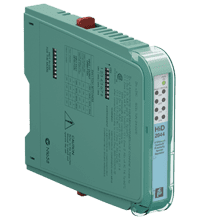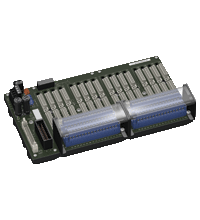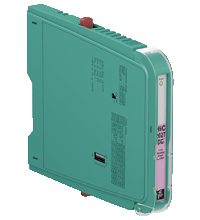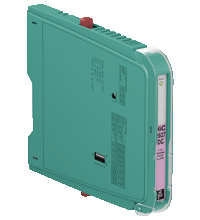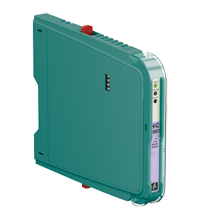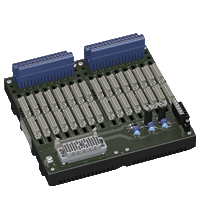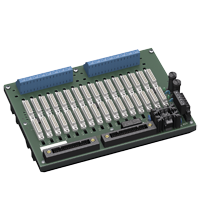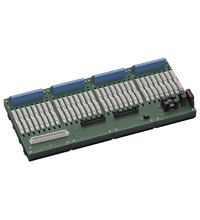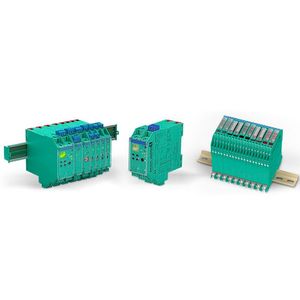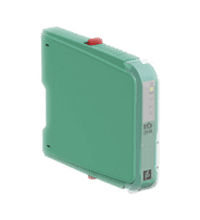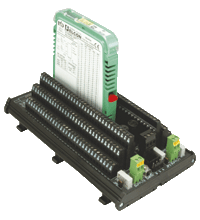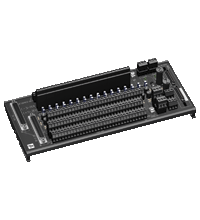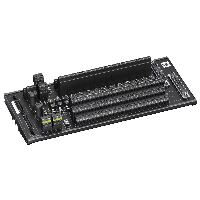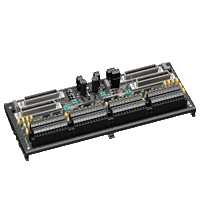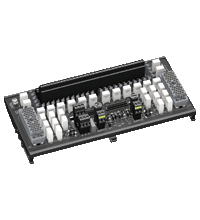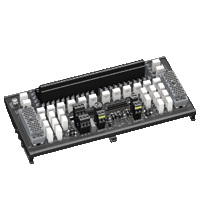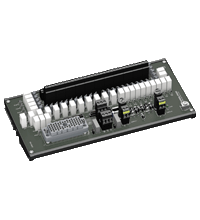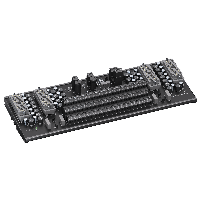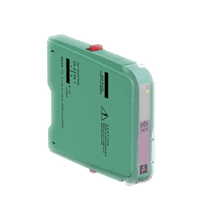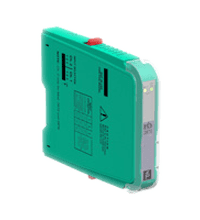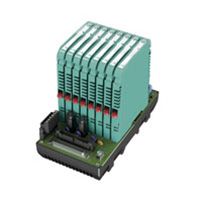Pepperl+Fuchs H-System
This item is out of production!
- 4-channel isolated barrier
- 24 V DC supply (bus powered)
- Dry contact or NAMUR inputs
- 4 passive transistor outputs
- Line fault detection (LFD)
- Up to SIL 2 acc. to IEC 61508
- System board for Honeywell Safety Manager
- For 16-channel AI card SAI-1620m
- For 16 modules
- Recommended module: HiC2025(A) (AI)
- 24 V DC supply
- Hazardous area: pluggable screw terminals, blue
- Non-hazardous area: SiC plug, 20-pin
- 1-channel isolated barrier
- 24 V DC supply (bus powered)
- Input for 2-wire SMART transmitters and current sources
- Signal splitter (1 input and 2 outputs)
- Dual output 0/4 mA ... 20 mA or 0/1 V ... 5 V
- Up to SIL 2 acc. to IEC 61508
- 1-channel isolated barrier
- 24 V DC supply (bus powered)
- Input for 2-wire SMART transmitters and current sources
- Signal splitter (1 input and 2 outputs)
- Dual output 0/4 mA ... 20 mA or 0/1 V ... 5 V
- Up to SIL 3 acc. to IEC 61508
- 1-channel isolated barrier
- 24 V DC supply (bus powered)
- Dry contact or NAMUR input
- Usable as signal splitter (1 input and 2 outputs)
- 2 passive transistor outputs
- 1-channel isolated barrier
- 24 V DC supply (bus or loop powered)
- Output 45 mA at 12 V DC
- Line fault transparency (LFT)
- Test pulse immunity
- Up to SIL 3 acc. to IEC/EN 61508
- System board for HIMA, HIMax
- For 16-channel card X-AO 1601 (AO, single mode)
- 16-channel card X-AO 1601 (AO, redundant mode on request)
- For 16 modules
- Recommended module: HiC2031 (AO)
- 24 V DC supply
- Hazardous area: spring terminals, blue
- Safe area: HIMA system connector, 96-pin
- System board for Triconex (approval TAN48)
- For 32-channel AI cards 3700A, and 3721
- For 16 modules
- Recommended module: HiC2025 (AI)
- 24 V DC supply
- Hazardous area: pluggable screw terminals, blue
- Safe area: ELCO socket, 56-pin
- System board for Yokogawa CENTUM VP
- For 16-channel AI cards AAI143, AAB141-H
- For 16 modules
- Recommended modules: HiC2025(A) (AI), HiC2081 (TI)
- 24 V DC supply
- Hazardous area: spring terminals, blue
- Non-hazardous area: Yokogawa system connector, 40-pin
- System board for Yokogawa CENTUM VP
- For 16-channel AI/AO card AAB841
- For 16 modules
- Recommended modules: HiC2025 (AI), HiC2031 (AO)
- 24 V DC supply
- Hazardous area: spring terminals, blue
- Safe area: Yokogawa system connector, 40-pin
- System board for HIMA, HIMax
- For 32-channel cards X-AI 32 01 or X-AI 32 02 (AI)
- For 32 modules
- Recommended modules: HiC2025 (AI), HiC2081 (TI)
- 24 V DC supply
- Hazardous area: spring terminals, blue
- Safe area: HIMA system connector, 96-pin
This item is out of production!
- 4-channel isolated barrier
- 24 V DC supply (bus powered)
- Analog in or analog out signals
- Sink and source mode outputs
- SMART pass-through
- Up to SIL 2 acc. to IEC 61508
This item is out of production!
2-channel isolated barrier
This item is out of production!
This Item is out of Production!
2-channel, 24 V DC supply, Current output up to 750 Omega- load
- 32-channel
- 24 V DC supply
- Interface for serial or parallel wiring options
- Dual RS 485 connections
- Slot for HART Multiplexer
- Ideal for retrofitting existing installations
- Interface for serial or parallel wiring options
- 37-pin Sub-D connectors
- Redundant power supply connections
- HART filter options
- Fuse options
- 32-channel
- 24 V DC supply
- For analog output cards
- HART output filters
- Interface for serial or parallel wiring options
- 37-pin Sub-D connectors
- Slot for HART Multiplexer
- TDC 3000 replacement FTA
- Short-circuit protected
- Redundant PCS wirings
- Redundant power supply connections
- Field terminal blocks that are Honeywell FTA compatible
- Honeywell ""B"" size footprint
- Triconex 3700A and 3721 replacement FTA
- 2- or 3-wire or self powered transmitters
- Outputs: 2 x 16 channels, 0 V ... 10 V differential, DC coupled (makes 32 channels)
- Short-circuit protected
- Plug-n-play wiring capabilities
- Triconex 3700A and 3721 replacement FTA
- 2- or 3-wire or self powered transmitters
- Outputs: 2 x 16 channels, 0 V ... 10 V differential, DC coupled (makes 32 channels)
- Short-circuit protected
- Plug-n-play wiring capabilities
- Optimized for use in floating power configurations
- Triconex 3704E and 3720 replacement FTA
- 2- or 3-wire or self powered transmitters
- Outputs: 1 x 32 channels, 0 V ... 5 V differential, DC coupled
- Short-circuit protected
- Plug-n-play wiring capabilities
- Triconex 3805E replacement FTA
- 32 channels of I/O
- Outputs: 4 x 8 channels, 4 mA ... 20 mA current loop, DC coupled
- Short-circuit protected
- HART analog output filters
This item is out of production!
- 1-channel isolated barrier
- 24 V DC supply (bus powered)
- 2-wire SMART transmitter
- Output for 4 mA ... 20 mA or 1 V ... 5 V
- Sink or source mode
- Line fault detection (LFD)
- Up to SIL 3 acc. to IEC 61508
This item is out of production!
- Product is phased out and cannot be ordered!!!
1-channel isolated barrier - 24 V DC supply (bus or loop powered)
- Output 60 mA at 13 V DC, 65 mA current limit
- Gas group IIB
- Contact or logic control input
- Line fault detection (LFD) with separate output
- Up to SIL 2 acc. to IEC 61508 (bus powered)
- Up to SIL 3 acc. to IEC 61508 (loop powered)
- Honeywell specific system cable for Honeywell Experion Series C GI/IO to Pepperl+Fuchs H-System termination boards
- Connects terminal plug on Honeywell Series C GI/IO TA to a single 37-pin Sub-D connector on H-System termination boards
- 20 m cable length
Pepperl+Fuchs H-System
The H-System consists of intrinsically safe isolated barriers that are used to protect intrinsically safe circuits in hazardous areas. In addition, H-System offers a terminal board-based interface solution for large plants and systems directly connected to DCS (Direct Control System)/ESD (Emergency Shutdown) systems. Let's find out more about Pepperl+Fuchs H-System technology.
Technical Advantages of Pepperl+Fuchs H-System
Pepperl+Fuchs H-System is a family of products designed for intrinsic safety in hazardous areas. These systems are known for their reliability and compliance with international explosion protection standards. Here are the main H-System advantages.
Intrinsically safe
The H-System is designed based on intrinsic safety principles, providing a high level of safety for electrical equipment in hazardous areas. This minimizes the risk of fire in explosive environments.
Global certification
Pepperl+Fuchs H-System products often have international certifications such as ATEX, IECEx, FM, and others. This ensures compliance with global standards and facilitates the use of these products in various regions.
Modularity
The H-System is often modular, allowing users to customize systems to suit their specific needs. H-System interface modules increase system design flexibility and simplify expansion or modification.
Flexible mounting options
H-System components are typically designed with flexible mounting options to suit a variety of installation scenarios. This adaptability makes it easy to integrate the system into different environments.
Robust design
The H-System is designed to withstand the harsh environmental conditions found in industrial environments. Rugged design ensures durability and reliability in harsh environments.
Diagnostic capabilities
H-System components can include advanced diagnostic functions to enable real-time monitoring and troubleshooting. This improves maintenance efficiency and reduces downtime.
Fieldbus compatible
H-System Fieldbus communication is designed to integrate with conventional Fieldbus networks, providing seamless communication with other devices and systems in the enterprise.
Comprehensive product range
The H-System includes a wide range of products including intrinsically safe barriers, isolators, signal separators, and power supplies. This breadth of offerings allows users to meet a variety of application needs within a single system.
Convenient configuration
H-System devices typically have user-friendly interfaces and configuration tools, making it easy for engineers and technicians to set up and maintain the system.
Improved security features
In addition to intrinsic safety, H-System products can include additional safety features such as fault detection and alarm functions to help create a safer work environment.
Explosion-proof enclosures
H-System components are designed with explosion-proof enclosures, providing an additional level of protection against potential hazards in explosive environments.
Application Scenarios in Hazardous Environments
The H-System is specifically engineered to ensure the safety and reliability of electrical and electronic equipment in these challenging environments. Here are some H-System applications.
- H-System components, including offshore platforms, refineries, and drilling sites, are often used in upstream and downstream oil and gas operations.
- Chemical manufacturing facilities where volatile substances are handled.
- Pharmaceutical production facilities where potentially explosive dust or gases may be present.
- H-System is employed in areas where intrinsic safety is required to control and monitor Underground mining environments with the potential for flammable gases or dust.
- Power plants, including those using fossil fuels or biomass.
- Facilities dealing with potentially explosive gases generated during wastewater treatment processes.
- Facilities such as tunnels and transportation hubs where flammable gases or vapors may be present.
- H-System components are utilized in various areas, including production units, storage facilities, and loading/unloading areas where there is a potential for explosive atmospheres.
- Water treatment and wastewater facilities where explosive gases can be generated.
- Maritime applications, including offshore oil and gas platforms.
Technical Installation and Configuration Guidelines
Here are general recommendations for installing and configuring the N-system.
- Security measures. Follow safety regulations to minimize the risk of accidents.
- Installation. Securely secure H-System components in their intended locations according to the manufacturer's instructions.
- Wiring. Use appropriate wiring methods, including the use of certified cables suitable for hazardous areas.
- Grounding. Follow proper grounding procedures to minimize the risk of electrical problems.
- Power supply. Ensure that the power supply to the H-system components is stable and within the specified voltage range.
- Housing protection. Make sure that the enclosures are sufficiently sealed and protected from dust, moisture, and other contaminants.
- Addressing. Assign unique addresses to each H-System module to prevent conflicts between them.
- Customization tools. Explore the configuration tools provided by Pepperl+Fuchs for the H-System.
- Communication protocols. If the H-System uses specific communication protocols, configure the modules accordingly.
- Diagnostic configuration.Configure diagnostic functions, such as setting alarms, and status indicators.
- Integration with the control system. Make sure the H-System is configured to seamlessly integrate with your overall control system.
- Testing and commissioning. Before putting the system into full operation, conduct thorough testing and commissioning.
Comprehensive Troubleshooting and Maintenance
Troubleshooting and maintenance of Pepperl+Fuchs Industrial safety solutions, which are often used in hazardous areas, are critical for ensuring the reliability and safety of industrial processes. Here's a comprehensive guide for H-system troubleshooting and maintenance.
Troubleshooting
- Begin by reviewing the documentation provided by Pepperl+Fuchs for the specific H-System components installed. Understand the system architecture, wiring diagrams, and troubleshooting procedures.
- Conduct a visual inspection of all H-System components, including barriers, isolators, and power supplies. Look for physical damage, loose connections, or any signs of wear.
- Verify the power supply to the H-System components. Ensure that the power source meets the specified requirements, and check for any fluctuations or interruptions.
- If available, use diagnostic tools provided by Pepperl+Fuchs to monitor the status of the H-System. Check for alarms, error codes, or any abnormal behavior.
- Perform isolation testing on barriers and isolators to ensure proper isolation between hazardous and non-hazardous areas. Use a multimeter to check for continuity and resistance.
- Test the field devices connected to the H-System. Check for proper communication, sensor readings, and actuator responses. Replace or repair faulty field devices as necessary.
- Verify the grounding of the H-System components. Poor grounding can lead to electrical issues. Ensure that grounding is by safety standards.
- Check the configuration settings of the H-System components. Ensure that the settings align with the application's requirements and the connected field devices.
- Consider environmental factors such as temperature, humidity, and exposure to corrosive substances. Ensure that the H-System components are within the specified operating conditions.
Maintenance
- Conduct scheduled inspections.
- Clean the components.
- Periodically calibrate the H-system components.
- Update firmware/software.
- Replace obsolete components.
- Analyze changes in process conditions.
